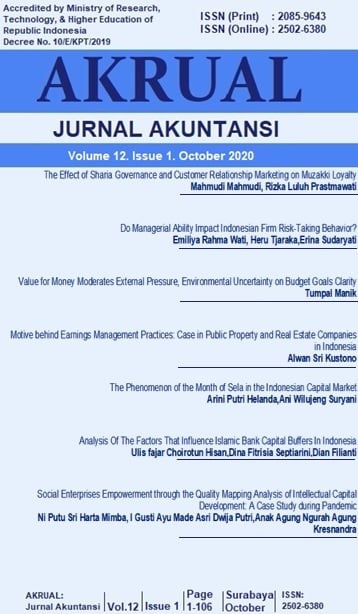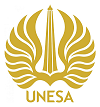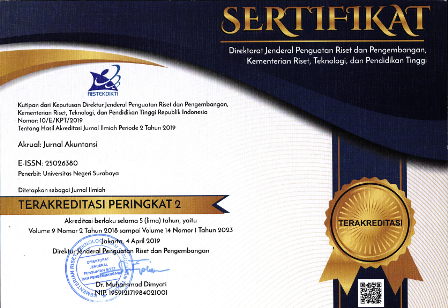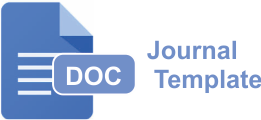Social Enterprises Empowerment through the Quality Mapping Analysis of Intellectual Capital Development: A Case Study during Pandemic
DOI:
https://doi.org/10.26740/jaj.v12n1.p94-106Keywords:
intellectual capital development, pandemic, Resource based Theory, social enterprise empowerment, quality mapping analysisAbstract
Abstract
During the pandemic period, government and society regard that social enterprises have more increasing role to reduce socials problems. Hence, there is an increased need to empowering social enterprises. This empowerment elevates their added value and competitiveness developing and improving their intellectual capital. However, the study on such development is not yet much explored. This study aims to fill this gap, especially in mapping the quality development of human, customer and structural capitals based on Resource Based Theory (RBT). The good quality of intellectual capital can enlarge the added value and competitiveness of social enterprises. This study is also develops the quality of intellectual capital to empowering social entreprises. This study used convenience sampling technique and obtained sample of 38 social entreprises. Quality mapping analysis and mean analysis are used to analyze the quality of each elemen of intellectual capital. This study finds that customer capital has the best development (mean score 166.9) followed by human capital (mean score 151.2) and then structural capital (mean score 145). This study also provides the mapping of some parts in the element of human, customer and structural capitals that require futher improvements. and possible solutions that doable and fruitful for social enterprises.
References
Bontis, N., Keow, W.C.C., & Richardson, S. (2000). Intellectual capital and business performance in Malaysian industries. Journal of Intellectual Capital, 1(1), 85-100. doi:10.1108/14691930010324188.
Cahyono, D & Qomariah, N. (2017). Intellectual Capital dan Kinerja Perusahaan. Jember: Cahaya Ilmu.
Marr, B. (2008). Impacting Future Value: How to Manage your Intellectual Capital. Management Accounting Guideline (MAG) Jointly Published by CMA, AICPA, and CIMA. Retrieved from https://www.journalofaccountancy.com/content/dam/jofa /archive /issues/2008/09/mag-intcapital-eng.pdf
Marr, B., and Schiuma, G. (2001). Measuring and Managing Intellectual Capital and Knowledge Assets in New Economy Organisations, in Bourne, M. (Ed.). Handbook of Performance Measurement, Gee, London.
Sawarjuwono, T., & Kadir, A. P. (2003). Intellectual Capital: Perlakuan, Pengukuran dan Pelaporan. Jurnal Akuntansi Dan Keuangan, 5(3), 3557. Doi: 10.9744/ jak.5.1. pp. %2035-57
Stewart, T., & Ruckdeschel, C. (1998). Intellectual Capital: The new wealth of organizations. Performance Improvement, 37(7), 56-59. Doi: 10.1002/pfi. 4140370713
Sugiyono. (2018). Metode Penelitian: Kualitatif, Kuantitatif, dan R & D. Bandung: Alfabeta.
Sveiby, K.E. (1997). The Intangible Assets Monitor. Journal of Human Resource Costing & Accounting, 2(1), 73-97. Doi: 10.1108/eb029036
Wernerfelt, B. (1984). A Resource-Based View of the Firm. Strategic Management Journal, 5 (2), 171180. Retrieved from http://www.jstor.org/stable/2486175
Downloads
Published
How to Cite
Issue
Section
License
Copyright (c) 2020 AKRUAL: Jurnal Akuntansi

This work is licensed under a Creative Commons Attribution-NonCommercial 4.0 International License.
 Abstract views: 564
,
Abstract views: 564
, PDF Downloads: 491
PDF Downloads: 491


















